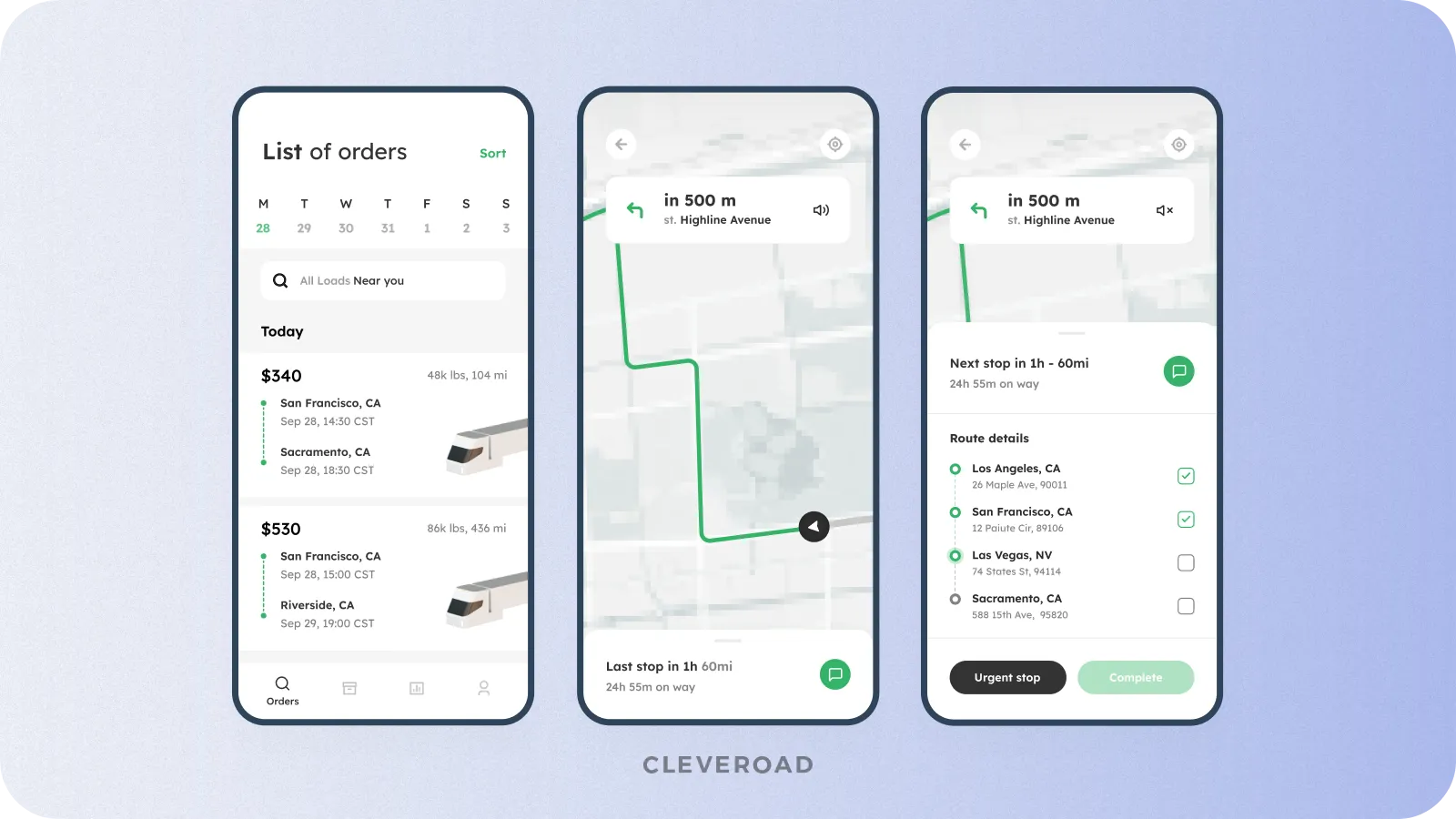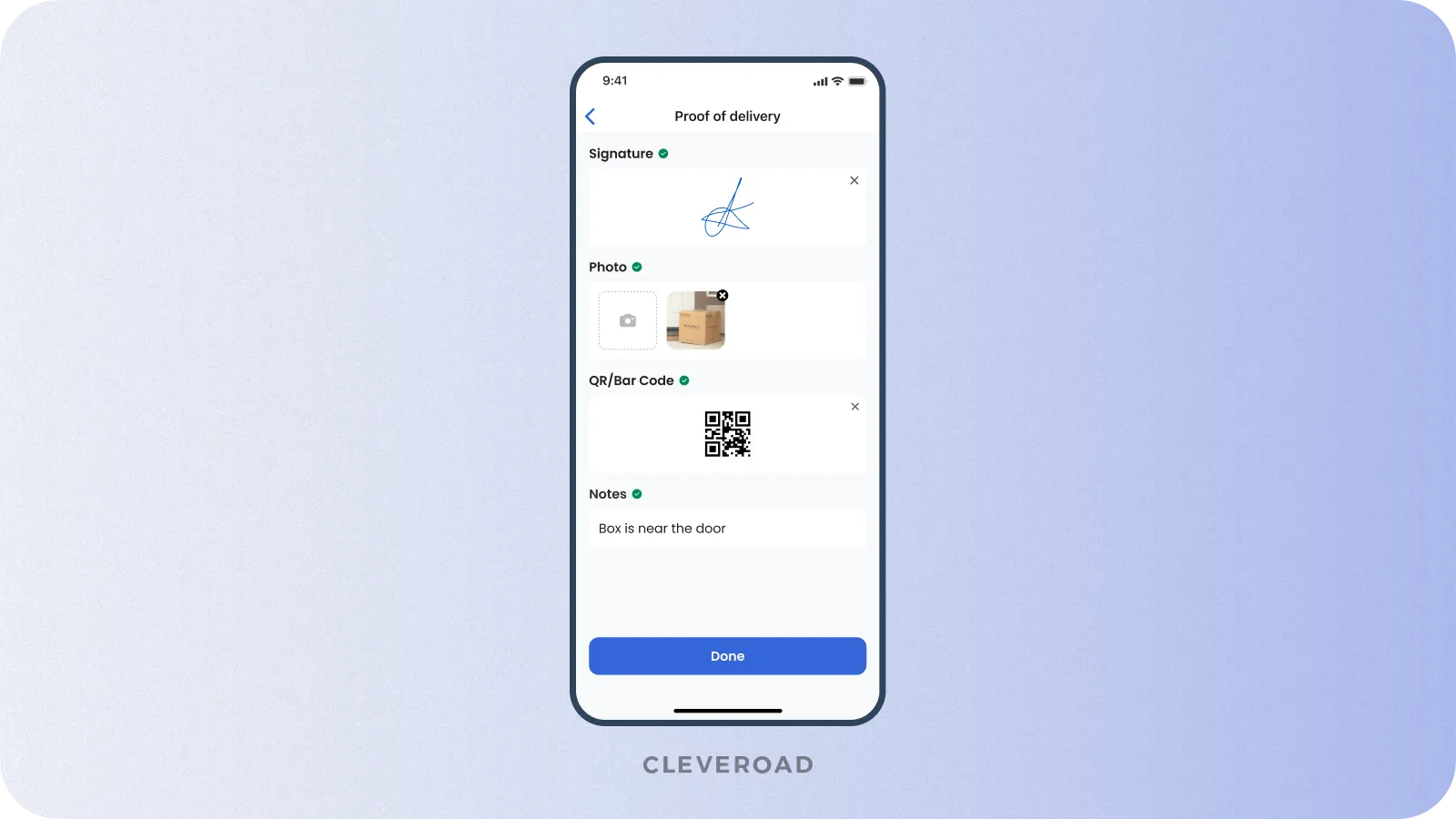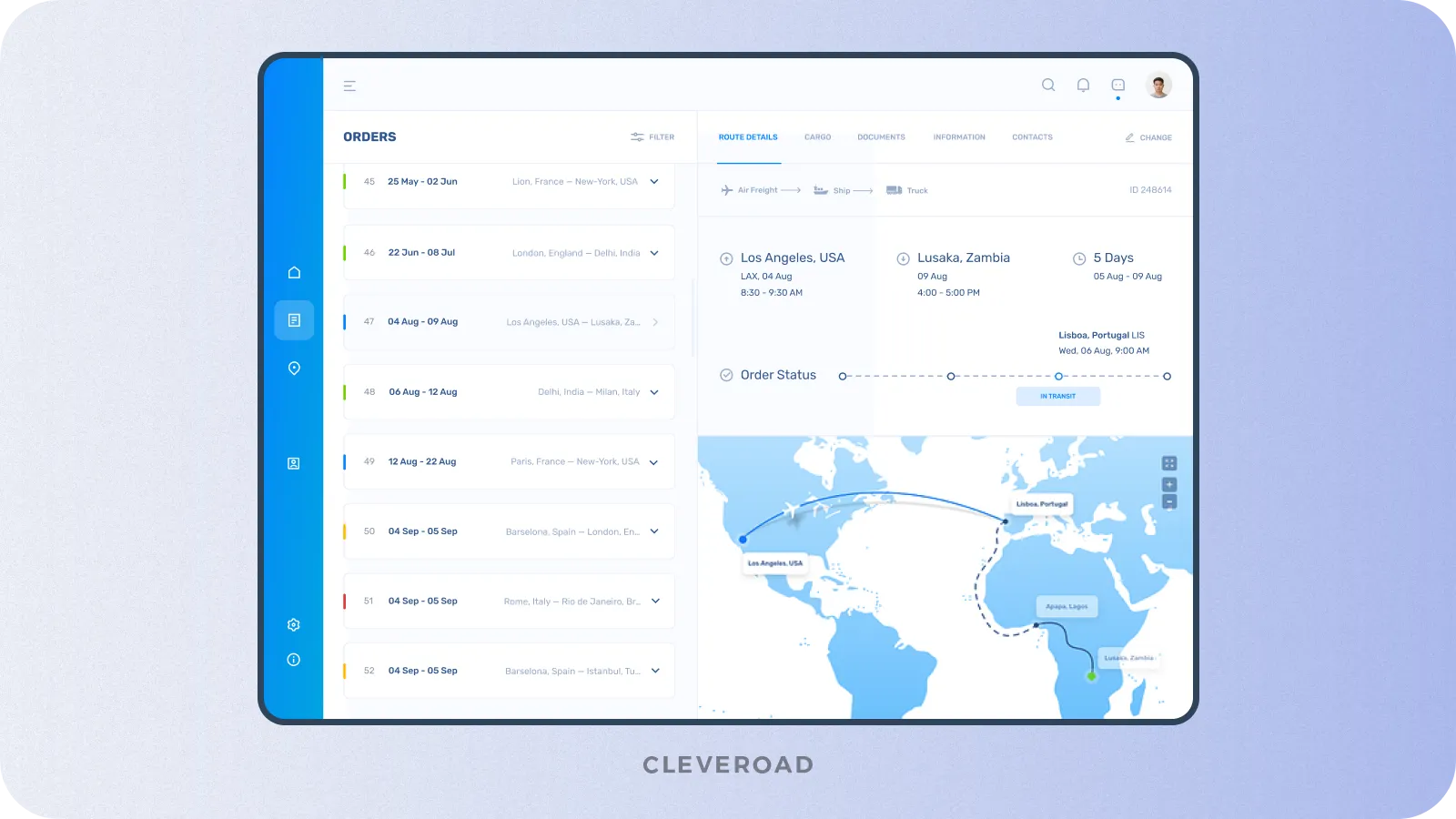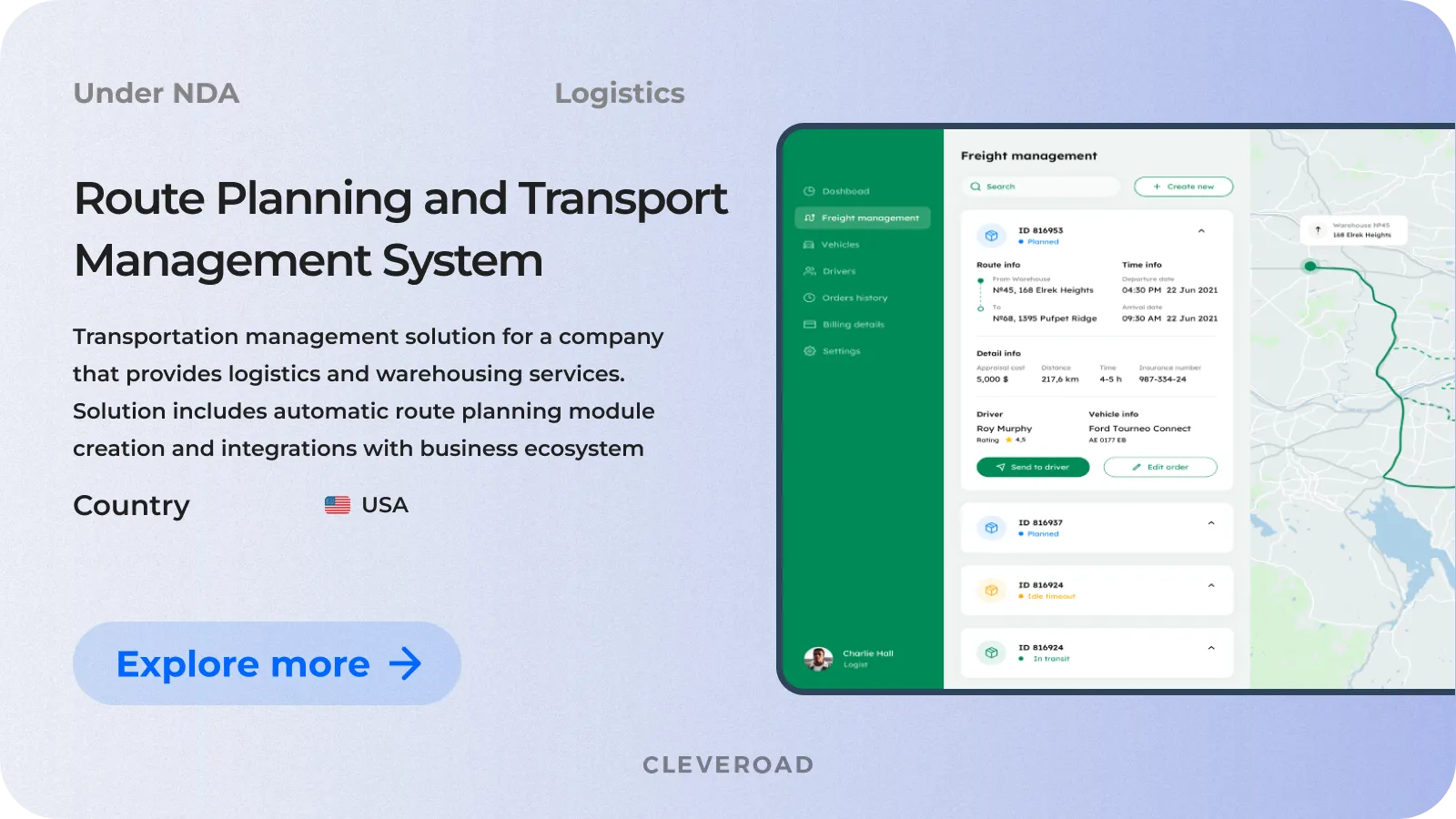How to Create a Transportation App: Features, Price, and Implementation Steps
29 Aug 2023
18 Min
573 Views
Logistics and supply chain management are constantly evolving and digitizing to meet customers' growing needs. Transportation applications significantly benefit logistics and transportation companies, and all other businesses rely on transportation. According to a study by Mordor Intelligence, the demand for transportation services is expected to grow at a CAGR of 4.07% during 2023 -2029. Thus, transportation software solutions provide an excellent opportunity for you to increase your transportation business share and outperform your competitors.
As an experienced IT provider with 11+ years of experience in Logistics, we at Cleveroad are ready to share our expertise in transportation app development and tell you all about the transportation app development, including functionality, cost of such a solution, and preparatory steps to ensure successful product launch.
What Is Transportation App, and Why Do Businesses Need It?
Transportation app is a specialized software designed to manage, optimize, and improve transportation and logistics processes. Building a transportation app provides transportation and logistics companies, as well as other businesses that depend on transportation services, for example, taxi services, rideshare platforms, or logistics providers, with the means to organize and coordinate the transportation of goods or people.
Here are the benefits of transportation app development for logistics and transportation organizations and all other businesses that rely on transportation services:
Route and time optimization. The transportation app allows you to automate the calculation of optimal routes for the delivery of goods or passengers, considering traffic, distance, and other factors. By optimizing routes, you can reduce travel time and fuel and resource costs. The study by THERMAL SCIENCE shows that route optimization lowers fuel costs by up to 20%.
Improved operational efficiency. Transportation apps provide real-time vehicle position and status tracking via GPS integration. Thus, transport app development allows you to quickly react to plan changes, prevent delays, and provide more accurate delivery time forecasting. According to Verizon Connect's survey, 75% of respondents indicated that GPS fleet monitoring significantly boosts the efficiency of each vehicle.
Better warehouse operations management. The transportation app can integrate with warehouse management systems to facilitate inventory tracking, management, and delivery planning. According to the SupplyChain 24/7 survey, about 36% of the respondents admit to a more balanced supply and demand model via predictive warehouse analytics and transportation app integration.
Improved customer experience. By providing customers with real-time data on the status and location of shipments or vehicles, the transporting app helps improve customer service and satisfaction. Moreover, according to a study conducted by Dot Distribution, delivery time affects 87% of the purchasing decisions made by online shoppers. Thus, transportation app development allows faster deliveries, increasing customer satisfaction and quantity.
Reduced costs. Optimizing routes and resources, more accurate scheduling, and more efficient transportation can reduce operating costs and improve business profitability. The ARC Advisory Group research shows that savings from optimization with transportation app development and integration can reach more than 10%.
Improved data analysis. The transportation app collects data on order fulfillment, routes, delivery times, and other critical aspects. Managers can analyze this information to identify trends, risks, and possible improvements in company performance. Forbes states that 85% of companies say that analyzing performance data allows them to succeed and grow faster.
Eco-efficiency. According to a study from Sustainable America, on average, the U.S. wastes about 3.8 million gallons of gasoline daily while idling in traffic. This is equivalent to 40000 tons of CO2. Optimizing routes and resources by creating a transportation app helps reduce CO2 emissions and other negative environmental impacts.

Transportation app example designed by Cleveroad (Source: Dribbble)
Preparations Steps Before Transportation App Development
Building a transportation app requires going through several important preparatory steps to help you identify your solution's essentials. Let's take a look at the main points you should pay attention to:
Define the purpose of your app
Before you start transport app development, determine what the purpose of your app is. Choose whether you want to create a SaaS-based solution to offer transportation services for a recurring fee. Or you want to develop an app tailored specifically to your transportation and logistics business. Clarifying the app's goal will help you focus on the required features and functions.
Analyze the market
Conduct a detailed market analysis to identify your app's target audience and study your competitors. Determine what needs and problems exist in the market and how your transportation platform can solve them. This step will help you better understand what features and modules should be included in your logistics solution. Also, by studying your competitors' experience, you can get valuable insights into their success and avoid their mistakes during app development for transport.
Choose a monetization model
Think about how you can make money by creating a transportation app. The monetization model for transport apps may include:
- Subscriptions. You can increase customer satisfaction with your transportation app by providing premium features when you purchase a subscription.
- Paid features. You can offer users additional paid features, such as a better class of cars or different interaction options, allowing users to optimize their trips.
- Advertising. You can also increase revenue by partnering with advertisers to display targeted ads while maintaining a seamless user journey.
- Transaction fees. Ensure a seamless transaction experience in your transportation app by charging users for completed trips or deliveries.
Choosing the suitable monetization model depends on your business goals and the type of ap you choose (e.g., freight and logistics apps, ride-sharing apps, package and courier delivery apps, food delivery app).
Select integrations (if necessary)
Consider what integrations might be helpful for your transportation app. The choice of integrations for transportation app development will depend on the type and goals of your platform. The integrations for your transporting app may include:
- Payment gateways
- GPS and mapping services
- Messaging and chat
- Weather services
- Ride-sharing APIs
- IoT devices
- Inventory manag systems
- APIs for multi-modal transport
- Analytics tools, etc.
Choose an experienced technical partner
A reliable IT partner who will create a quality solution that meets all your business needs is key to successful transportation app development. Research the market and compare different options. Ensure the vendor you choose has solid experience in Logistics app development, study the portfolio to assess the company's expertise, and check customer reviews on platforms like Clutch. A professional software provider will help you with intelligent transportation systems development, advise you on potential issues, and help you through all the preparatory steps. By cooperating with a reliable tech partner right from the initial stages, you can better plan the project and develop a transportation app with the necessary functionality for for your target audience.
Technical Side of Transportation Mobile App Development: Features to Add
Transportation mobile application development implies building three separate solutions to meet the needs of various user roles:
- Customer-facing solution
- Driver solution
- Admin panel
Each of them has its unique features. Let's take a closer look at features required for each side:
Customer side
The customer side of the transportation app is created to provide an interface and functionality for end users who will use the app to access the transportation service. Features of the customer side include:
User registration and authentication. Users need to register to start using the app. Customers can sign up via email, phone number, or social media accounts. Authentication provides secure access to personal information and app features.
Ride booking and scheduling. This feature allows customers to select the pickup point and destination, specify the date and time of the ride, and select the type of vehicle (e.g., car or minivan). Users can also set additional requests (e.g., child seats).
Real-time GPS tracking. The GPS tracking feature provides users with real-time information about the vehicle's location. This allows users to accurately time the driver's arrival time and track their movement during the trip.
Real-time GPS tracking feature example designed by Cleveroad
Fare estimation and payment processing. Users can estimate the preliminary cost of a trip based on the specified distance and travel time. The payment processing system allows users to conveniently and securely pay for trips through the app.
Ratings and reviews. After completing a ride, users can rate and leave feedback on the quality of service and the driver's professionalism. Also, users can see drivers' ratings when booking a ride. This helps to improve user experience and ensure the quality of services.
Notifications and alerts. This feature allows customers to stay up-to-date with the latest information about their booking. The transportation app can notify them about order confirmation, driver approaching, trip start and end, etc.
Trip history and receipts. The user's history of all previous trips should be available in the application. Customers can view a receipt of each trip detailing the cost, time, and place of the trip's start and end.
Support and contact options. The support feature allows users to get assistance with any questions or concerns. Contact options ensure efficient interaction with the support team. You can also add the ability to contact the driver in the transportation app to improve the user experience.
Driver side
The driver app is designed to allow drivers to organize their work efficiently, providing them with all the necessary tools and data. The essential functions for creating a transportation app for drivers include:
Driver registration and verification. Drivers can register in the app by providing their data, including their driver's license and insurance. Verification of this data ensures customer trust and safe travel.
Ride acceptance and assignment. Drivers can accept ride requests sent by customers. This feature also allows them to assign bookings according to their availability and location.
GPS navigation and route optimization. GPS navigation helps drivers optimize their route to deliver a passenger or cargo in the shortest and most efficient way. For efficient route optimization, the application must consider current road conditions, including weather, traffic jams, road repairs, etc.
Earnings tracking and payment details. The earnings tracking feature allows drivers to monitor their earnings for each trip. Payment details will let carriers control their income structure and keep it financially organized.
Communication with customers. Drivers can communicate with passengers through built-in communication tools. This feature allows drivers to solve any questions, clarify order details and a boarding place, and ensure a comfortable journey.
Proof of delivery (POD) capture. This feature allows drivers to capture proof of delivery, such as photos of the delivery location or the recipient's signature. Proof of delivery provides accurate confirmation of order fulfillment.

Example of proof-of-delivery capture designed by Cleveroad
Admin panel
Transportation app development also requires the creation of a reliable and user-friendly admin panel. With its help , logistics managers can manage and control various elements of transportation operations (e.g. vehicles, routes, drivers, etc.). Moreover, this tool provides payment and financial management, control over users and driver support processes, as well as maintenance and support in case of concerns. Overall, the admin panel plays a crucial role for centralizing and monitoring all the freight-related activities , as well as maintaining a positive customer and partner experience.

Example of Admin panel for transportation solution developed by Cleveroad (Source: Dribbble)
Integrated transportation app within logistics systems
Suppose you plan to develop a transportation app that integrates freight operations with the functionality of other logistics management systems. Here are the key features of integrated transportation applications:
Seamless integration. Seamless integration allows the transportation application to be linked to logistics software, warehouse management and order management systems without significant gaps and errors in data transfer. This way, you can ensure continuous information exchange and reduce the risk of errors.
Supply chain visibility. The feature provides complete visibility of the entire supply chain, from shipment to delivery. Thus, the transport app allows you to track the movement of goods in real time, prevent delays, and optimize planning.
Fleet management integration. Integration with fleet management systems allows you to monitor vehicle status and availability, plan maintenance, and optimize resource utilization.
Order and shipment tracking. This feature provides continuous monitoring of orders and shipments at all stages of the journey. For both customers and logistics operators, it significantly increases reliability and confidence in the delivery process.
Route optimization and planning. Optimizing routes based on road conditions, congestion, and time can reduce delivery time and fuel costs, improving operational efficiency. Moreover, you can fulfill more orders without engaging new employees and vehicles.
Carrier and provider integration. Integration with external carriers and providers makes ordering and coordinating deliveries with multiple partners easy, providing flexibility and service choice.
Reporting and analytics. Reporting and supply chain analytics provide valuable information on delivery progress, operational efficiency, and key metrics. This way, the company can make more informed decisions to improve transportation process flow.
EDI integration. Electronic Data Interchange (EDI) integration enables electronic data exchange between different systems, improving order and payment processing accuracy and speed.
Last-mile delivery management. Integration with last-mile delivery software will allow you to track and coordinate delivery directly to the final recipient, ensuring high customer satisfaction.
Going Through the Steps of Building a Transportation App
Now that you know the basic preparatory steps and features, let's learn how to create a transportation app using our Software Development Life Cycle (SDLC) as an example.
1. First contact
Communication begins when you leave a request on our website. Your personal manager with expertise in Logistics will contact you within 24 hours to clarify details and move on to the next stage. Also, we sign a Non-Disclosure Agreement (NDA) at this stage upon your request.
2. Solution Design stage
At this stage, we schedule for you a meeting with the Solution Design team, which consists of Business Analysts, Solution Architects, and Designers. The experts will discuss your requirements and wishes for the app development. Also, at this stage, the team defines business goals, key quality attributes, scope of work, etc. Based on this information, we provide you with a rough estimate, team composition, and timeline. After that, the team forms a proposal.
3. Discovery Phase
Going through the Discovery Phase allows the team to turn your product requirements into a clear plan for custom transportation management system. Hence, this phase speeds up the development and improves the product quality. At this stage, the team conducts an in-depth analysis of the project’s requirements, specifying the platforms you want to cover, features to add, and 3rd-party services to integrate. We also prepare a detailed Feature Breakdown List, design concept, UX map, etc. Upon completion of this phase, business analysts prepare a detailed estimate. If you agree with all terms and conditions, we will conclude a contract for developing a transportation app.
Unveil how Discovery Phase in software development can improves your transport app quality
4. Product development
After completing all the preparatory steps, the team builds a transportation app. Developers create each part of your software during sprints, which usually last about two weeks. Before each of them, the team will discuss with you the task, allowing you to make changes if necessary. Also, each sprint is accompanied by a quality assurance to fix any possible bugs and ensure the system functions properly.
You may want to build a transportation app as a standalone solution, or it can be integrated into your business environment. Thus, the engineering approaches will differ depending on your needs. Let’s overview both cases.
If you want to build a SaaS transportation app to offer it to logistics businesses — you can start by building a Minimum Viable Product (MVP). The MVP version of an app includes the minimum required set of features features required to run the application and meet the basic expectations of users. This approach allows you to quickly test the app idea with minimal cost and time investment, assess market demand, and get initial feedback, which is essential for further product improvement.
If you want to integrate an application into your logistics management systems, you can start with Proof of Concept (POC). A POC creates a limited iteration of transportation app development to demonstrate and validate a concept's key technical, functional, or strategic aspects before implementing the full solution.This method allows you to reduce risk to your business, save time and investment on concept testing, and get feedback from users early in the development process to create a more effective transport platform.
Technology stack for transportation app development may include:
| Type of work | Technology stack |
Front-end | HTML, CSS, JavaScript (React, Angular, Vue.js) |
Back-end | Node.js, Ruby on Rails, Django, ASP.NET |
Mobile | Swift, Java |
Database | MySQL, PostgreSQL, MongoDB |
Integrations | RESTful API, GraphQL |
Cloud services | Amazon Web Services (AWS), Microsoft Azure, Google Cloud Platform |
Communication | WebSocket, Twilio |
5. Deployment or release
Once development and testing are complete, the team is ready to launch your transportation app. If you have an autonomous solution, we help you publish it to app stores (like Apple App Store or Google Play Store) or or live servers. We can also assist in deploying the app on cloud computing services (e.g., AWS). If it is an integrated transport solution, our experts incorporate the app into your logistics business environment.
6. Maintenance and support
After the transportation app development and its release, our cooperation does not end. You may require support and maintenance services to improve your solution These services contain creating richer functionality and update it for new OS versions, code optimization, stability and performance improvements, and bug fixing.
How Much Does It Cost to Develop a Transportation App?
The cost of transportation app development can depend on many factors, including the type of solution, number and complexity of features, design specifics, development time, platforms you want to cover, etc. Considering these factors, the average price can range from $50,000 to $250,000+. To reduce the cost of app development, you can turn to cooperation models: Outsourcing or Outstaffing. The model you choose depends on your company's needs:
Outstaffing. This cooperation model suits you if you have your in-house team but need to expand their expertise by hiring remote experts. For example, you need 1 developer, 1 designer, and 1 QA engineer. Or you want to free up your employees and need additional experts for a specific project or timeframe. This way, you can turn to a reliable software vendor who will provide you with the necessary skill set to expand your team. They will become a part of your team and will work under your supervision or your Chief Technology Officer/Project Manager. Outstaffing allows you to get the necessary expertise without long-term commitment and administrative costs of hiring full-time employees.
Outsourcing. This cooperation model implies hiring an entire team to handle the end-to-end app development process. By turning to an outsourcing software vendor, you will get a pre-screened team of specialists who will work independently on creating your product, reporting directly to you or your Chief Technology Officer/Project Manager. By choosing to outsource, you can significantly reduce the app development costs and get access to experts worldwide. Moreover, you will speed up time-to-market by reducing the time to find and hire each specialist separately.
To give you a hint, we’ve analyzed the hourly rates in the most popular outsourcing destinations, so you can select the most suitable region. These rates are compiled from Clutch, UpWork and GoodFirms.
| Popular outsourcing region | Avg hourly rate ($) |
North America | $100-$200 |
South America | $35-$60 |
Western Europe | $75-$150 |
Central and Eastern Europe | $25-$70 |
Asia | $20-$40 |
Australia | $80-$120 |
As you can see, hourly rates vary across the regions. Software engineers from North America, Western Europe, and Australia have a good reputation, but the cost of their services is relatively high. Moreover, high cost does not always mean the best quality.
Asia and South America offer the lowest IT consulting cost. But, working with outsourcers from these regions, you may encounter certain difficulties, including communication challenges and organization and low customer focus.
Central and Eastern Europe is considered a good choice. There are many experienced outsourcing companies with good references. Nevertheless, the cost of their services remains relatively low, as this area has low taxes and high government support for the IT sector.
Cleveroad’s Portfolio Of Transportation Solutions
We would like to present you some of our logistics project our team successfully delivered for transportation companies:
Transport Management System with route planning
Our specialist built a transportation management system (TMS) and integrated it with existing logistics solutions for our client — a logistics company from the USA. The goal of the TMS was to automate route planning and transportation management. To address client's business needs, we implemented the following modules:
- Route planning
- Fleet management
- Delivery points management
- Jobs for delivery
- Access system for company staff
We also built a route planning mobile app for truck drivers with navigation functionality. Moreover, our team provided reliable integration with the existing Warehouse Managememt System (WMS) and CRM.
As a result, our customer received custom TMS system, tha allowed to achieve total delivery time optimization, logistic overhead reduction by 27-36% due to automation, better control of vehicles and route planning.
P2P solution for on-demand rides and delivery
Another of our cases is the development of a digital solution for a transportation company from the USA. We created a transportation app (based on the Uber model) that connects drivers with riders throughout the area. To address clients' business needs, we integrated the following features:
- Driver validation
- Event-driven tracking and communication system
- Sophisticated filtering system
- Free-ride option
- Integration with payment systems for in-app payments
As a result, the client received a full-fledged transportation app that allows the company to provide services and receive revenues according to the chosen business revenue model and increase the value of their business.
Here’s the opinion of our client left on Clutch about their successfull cooperation experience with Cleveroad:
John Salmon
Owner, MoveUp
Cleveroad built a high-quality app that's received lots of positive feedback from testers thus far.
Cleveroad Expertise in Logistics and Transportation App Development
If you are searching for an experienced IT partner for transport app development, the Cleveroad team is ready to help you. For over 11 years, we have been helping startups and enterprises to automate their logistics and transportation services with custom technical solutions. Our team has practical experience creating various logistics solutions, including Warehouse Management Systems (WMS), Transportation Management Systems (TMS), Enterprise Resource Planning (ERP), and other logistics software and mobile apps.
By partnering with Cleveroad, you will receive a number of benefits, including:
- Full-service logistics software development including Solution Design and Discovery phases, development, quality assurance, and support services
- Experience in integrating logistics and transportation solutions with external systems or 3rd party services such as Google Maps, Xero, SAP ERP, Salesforce, LogistaaS, UpKeep, Netsuite, etc.
- On-demand IT services: integration with IoT devices (e.g. GPS trackers), MVP/PoC creation, legacy software modernization, IT consulting, cloud-based development, DevOps servcies, etc.
- Consultation on the details of your transportation application with our Logistics Business Analysts and Solution Architects.
- Signing a Non-Disclosure Agreement (NDA) upon your request.
- Flexible cooperation models: outstaffing, dedicated development team, time & material, etc.
Transportation app from domain experts
Our team with 11+ years of experience in logistics software development is ready to build transportation app to ensure timely deliveries
A transportation app is specialized software designed to manage, optimize, and enhance transportation and logistics processes. It offers functionalities like route optimization, real-time tracking, automated processes, and integration with various systems.
Creating a transport app involves several key steps. First, define the purpose of your app – whether it's a standalone SaaS-based solution or integrated into your logistics systems. Conduct market analysis to identify your target audience and competitors. Choose a monetization model. Then select necessary integrations like GPS, payment systems, and more. Finally, look for an experienced development team to design, develop, test, and deploy your app.
Transportation apps offer a range of benefits, such as cost and time savings, enhanced operational efficiency through real-time tracking, routine tasks automatization,improved customer experiences, better data analysis, etc.
The cost of developing a transportation app varies based on factors like the type of app, features, complexity, design, platforms, and more. Commonly, the cost for such a solution can range from $50,000 to $250,000 or more.

Evgeniy Altynpara is a CTO and member of the Forbes Councils’ community of tech professionals. He is an expert in software development and technological entrepreneurship and has 10+years of experience in digital transformation consulting in Healthcare, FinTech, Supply Chain and Logistics
Give us your impressions about this article
Give us your impressions about this article

